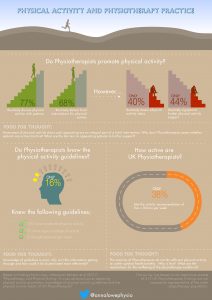Aiming to exercise for 30 minutes a day, five times a week, with two days of resistance training is important. There are a number of ways which people can become physically active, through structured exercise, walking, cycling, doing housework etc…
Although physical activity promotion can be a community based intervention, physiotherapists are in a unique position to be able to create physical activity programs to improve the health and fitness and individuals, while concurrently addressing musculoskeletal impairments. We can assist in questioning current physical activity levels, undertaking fitness assessments, and providing activity recommendations. To increase the physical activity levels in the community, health practitioners should incorporate it’s promotion as a routine component of their interventions (Freene, Coole & Besset, 2017)
Everyone benefits from exercise, but when dealing with individuals, we must consider preferences, experience and comorbidities. We must make ‘every contact count’.
Although physical activity promotion is a government, local and community wide role, this section will focus on the physical activity for physiotherapists and health professionals who have regular contact with patients, and the opportunities associated with these interactions. According to Orrow, et al, for primary care practitioners to successfully encourage one person to meet the ACSMs guidelines of 150minutes per week, the number needed to treat (NNT) is 12.
Physical activity knowledge and promotion amongst Australian physiotherapists is poor (Freene, Cool & Bisset, 2017) and physiotherapists in the UK have a poor knowledge of the guidelines.
Below is a great review that is concerned with the promotion of physical activity from physiotherapists in the UK that is open access on BMJ Open SEM

More great content like this can be found from @annalowephysio Tweet to @annalowephysio
- Physiotherapists are well versed to utilise physical activity as an intervention strategy to manage long term conditions and opportunities exist to promote the benefits of a healthy lifestyle due to contact time
- However, physical activity is not being comprehensively promoted within the health care setting with a perceived lack of contact time with patients acting as a barrier to implementation
So how should we encourage patients to become physically active?
- Physical activity is about the feeling of well-being, as well as promotion of health markers. Every individual has their own sets of goals, reasons for physical activity/inactivity and these must be considered by the health professional
- It may be beneficial to educate them on the ways in which physical activity can help them accomplish their goals, create enjoyment, well-being and pleasure through a patient-centred approach. This can improve patient autonomy. (Segar et. al. 2016)
- This approach is the opposite of acting purely from a clinician-centred approach which can be concerned with meeting health indicators (i.e. blood pressure) that may fail to consistently motivate our patients where immediate results are not noticed.
- When physical activity goals are recognised, they can act to strengthen the behaviour and how PA is perceived and experienced.
“Health is valuable because it provides the energetic resources people need to live well. Without health, people lack the requisite energy to pursue their most meaningful goals and roles. In this perspective on health, health is not the end goal; instead, its function is to be the intermediary of the real driver of what matters most: vitality and energy.” (Segar, Guerin, Phillips & Fortier, 2016, p. 277)
- Although it should be encouraged, physical activity recommendations should not be a one-size-fits-all recommendation
- Creating standards which are medically focused and requiring patients to ‘hit targets’, may denote that anything below these is a failure
Physical activity readiness questionnaire – Indicates whether an individual should seek further medical consultation before starting an exercise program
Self-efficacy for exercise questionnaire – Provides information regarding the perception of success with physical activity
Physical activity enjoyment scale – Provides information about the enjoyment a person gains from physical activity
- Here is a great booklet to be able to give to our patients by Exerciseworks!
- UK physical activity guidelines from UK Gov
Supporting Texts/Articles/Medias
Australian Government – Department of Health
http://www.exercise-works.org/
